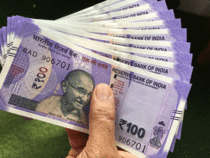Mumbai: The Indian rupee appreciated by 36 paise to 71.30 against the US dollar in early trade on Thursday as gains in domestic equity market and fresh foreign fund inflows strengthened investor sentiments.
Forex traders said Trump delaying the increase in Chinese tariff by 15 days enthused investors.
US President Donald Trump has announced the delay of his proposed massive increase in Chinese import tariffs by 15 days.
At the interbank foreign exchange the rupee opened at 71.46, then gained further ground and touched a high of 71.30, registering a rise of 36 paise over its previous close.
The domestic unit however could not hold on to the gains and was trading at 71.35 against the dollar at 0949 hrs.
On Wednesday, the rupee had settled for the day at 71.66 against the US dollar.
Describing this as a goodwill gesture, Trump said on Wednesday night that he had moved the increased tariffs on $250 billion worth of goods from October 1 to October 15.
"At the request of the Vice Premier of China, Liu He, and due to the fact that the People's Republic of China will be celebrating their 70th Anniversary on October 1st, we have agreed, as a gesture of good will, to move the increased Tariffs on 250 Billion Dollars worth of goods (25 per cent to 30 per cent), from October 1st to October 15th," Trump tweeted.
Besides, higher opening in domestic equities and weakening of the American currency vis-a-vis other currencies overseas supported the local unit.
Domestic bourses opened on a positive note on Thursday with benchmark indices Sensex trading 139.69 points higher at 37,410.51 and Nifty up 41.20 points at 11,076.90.
The dollar index, which gauges the greenback's strength against a basket of six currencies, fell marginally by 0.01 per cent to 98.63.
Foreign institutional investors (FIIs) remained net buyers in the capital market, putting in Rs 266.89 crore on Wednesday, according to provisional exchange data.
Brent crude futures, the global oil benchmark, rose 0.72 per cent to trade at $61.25 per barrel.
Published On : 12-09-2019
Source : Economic Times

